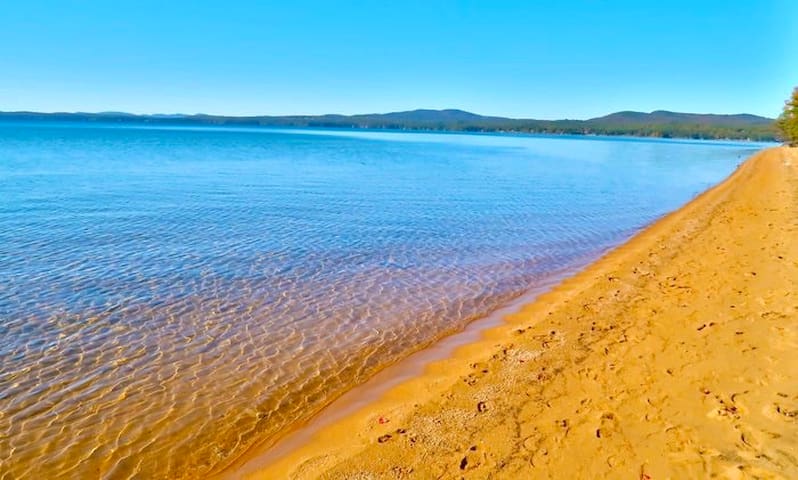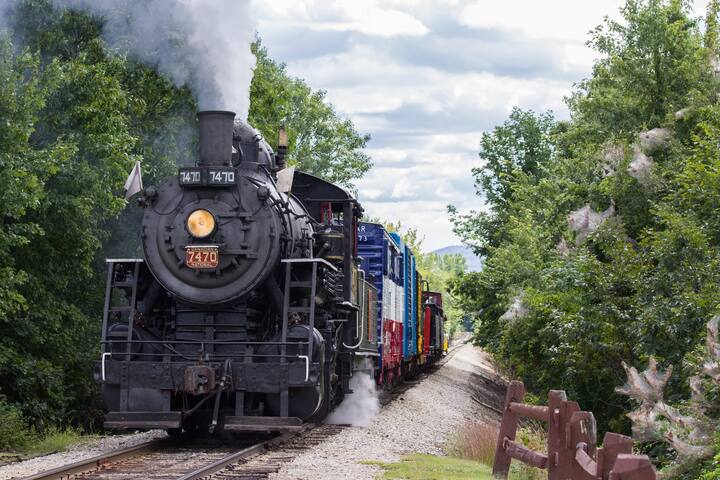Wedding Venue
A unique space for a wedding ceremony and reception sitting on 20 acres overlooking Sebago Lake.
Autumn Lane Estate
Located in the town of Sebago, just minutes from the lake is a charming and rustic New England barn and flower farm nestled amongst the mountainous pine forests of Western Maine.
Garden Gate at Haley Farm
432 Convene RdLocated in the town of Sebago, just minutes from the lake is a charming and rustic New England barn and flower farm nestled amongst the mountainous pine forests of Western Maine.
The Stone Barn at Sebago Lake
Food / Beverages
Naples
Gemmes General Store
773 Sebago RdAmazing sandwiches and pastries made right here....and knelt 5 minutes away
Foliage, “Leaf Peeping”
Amazing mountain / foliage trip in the fall!
Kancamagus Highway
Beach / Boating / Fishing
Activities the region is known for.
Nason's Beach & Campground
771 Sebago RdNice sandy beach and boat ramp. 5 minutes away.
At 45 square miles, Sebago is Maine’s second largest lake and, with a maximum depth of 305 feet, its deepest. The lake is home to several species of game fish, most notably landlocked salmon, which bears the Latin name of Salmo sebago. Indeed, descendants of Sebago’s native salmon now populate many of the deep lakes and cold-water rivers of northern New England.
Small, flashy spoons will tempt spring salmon.
Boat fishing for salmon begins right after ice-out, which typically occurs in mid- to late April. At this time, the fish feed closer to the surface as they pursue smelt. The fishery hits high gear in the first half of May—prime time for trolling spoons and flies near the surface on light gear, according to local sharpie Charlie Frechette of Sebago Marina. Hot spots include the waters between Spider Island and the Muddy River, as well as the area between the Songo River and Bear Point. Proven lures include the DB Smelt, Speedy Shiners, and similar smelt-imitating spoons. Effective flies include the Magog Smelt, Barnes Special, Senator Musky, and Winnipesaki Smelt.
Shiners hooked through the nose and slow-trolled on leadcore line can be deadly on salmon.
Live bait is also popular and effective, but requires a slower trolling speed (around 1.5 mph). Many anglers employ a spread consisting of both downrigger and leadcore lines, staggered at different distances behind the boat and at different depths.
Sebago produces some excellent smallmouth fishing, especially in June.
Once June rolls around, the salmon and smelt move to deeper water (50 to 80 feet), which triggers a switch to downrigger trolling. Frechette generally fishes two downrigger lines at 45 to 55 feet, and two at 75 to 85 feet. He says the salmon (and other game fish) will usually hold around suspended schools of smelt. A good fishfinder is useful for finding the smelt, but the presence of gulls sitting on the water can also indicate bait below. Again, the top lures are smelt-imitating spoons like the Speedy Shiner in Brown Trout, red/gold and chartreuse/silver patterns.
Another popular Sebago sport fish is lake trout, or togue. These fish can weigh up to 20 pounds, although a five-pound fish is considered a good catch these days. While anglers often catch trout while fishing for salmon around the smelt schools, another method involves trolling large Murray spoons close to the bottom off downriggers at two to four mph. Areas where the lake bottom rises to form humps, or other forms of deep-water rocky structure, are good spots to find lakers.
Sebago also has an outstanding fishery for smallmouth bass, with the month of June producing great light-tackle action around rocky areas in three to ten feet of water. Poppers, jerkbaits, “wacky-rigged” worms, and flies all work well at this time. The bass typically move to deeper structure and drop-offs in 15 to 35 feet of water through the summer and early fall. This is when jigging soft-plastics, tube lures, and bucktails, as well as fishing live bait (shiners and worms), become the most productive methods. Still, it’s often possible to find big fish in relatively shallow water through summer, especially in the early morning and evening.
Sunfish and other panfish are available in some of the shallow coves, providing fun for kids throughout the day. Good spots include mud-bottom areas such as Turtle Cove and the Muddy River. Try using small worms below a bobber or light jigs tipped with meal worms or grubs.
For information on access, check out Fishing Hot Spots. They publish an excellent—and essential—chart and boating guide for Sebago showing all of the lake’s ramps and depths.
Bait & Tackle
* Jordan’s Store (207-787-3866
Charters
Sebago Lake Fishing Charters & Tours (207-939-6971)
BUY A FISHING LICENSE ONLINE
(MOSES) Maine Online Sportsman Electronic System
36 lokale anbefaler
Sebago Lake
At 45 square miles, Sebago is Maine’s second largest lake and, with a maximum depth of 305 feet, its deepest. The lake is home to several species of game fish, most notably landlocked salmon, which bears the Latin name of Salmo sebago. Indeed, descendants of Sebago’s native salmon now populate many of the deep lakes and cold-water rivers of northern New England.
Small, flashy spoons will tempt spring salmon.
Boat fishing for salmon begins right after ice-out, which typically occurs in mid- to late April. At this time, the fish feed closer to the surface as they pursue smelt. The fishery hits high gear in the first half of May—prime time for trolling spoons and flies near the surface on light gear, according to local sharpie Charlie Frechette of Sebago Marina. Hot spots include the waters between Spider Island and the Muddy River, as well as the area between the Songo River and Bear Point. Proven lures include the DB Smelt, Speedy Shiners, and similar smelt-imitating spoons. Effective flies include the Magog Smelt, Barnes Special, Senator Musky, and Winnipesaki Smelt.
Shiners hooked through the nose and slow-trolled on leadcore line can be deadly on salmon.
Live bait is also popular and effective, but requires a slower trolling speed (around 1.5 mph). Many anglers employ a spread consisting of both downrigger and leadcore lines, staggered at different distances behind the boat and at different depths.
Sebago produces some excellent smallmouth fishing, especially in June.
Once June rolls around, the salmon and smelt move to deeper water (50 to 80 feet), which triggers a switch to downrigger trolling. Frechette generally fishes two downrigger lines at 45 to 55 feet, and two at 75 to 85 feet. He says the salmon (and other game fish) will usually hold around suspended schools of smelt. A good fishfinder is useful for finding the smelt, but the presence of gulls sitting on the water can also indicate bait below. Again, the top lures are smelt-imitating spoons like the Speedy Shiner in Brown Trout, red/gold and chartreuse/silver patterns.
Another popular Sebago sport fish is lake trout, or togue. These fish can weigh up to 20 pounds, although a five-pound fish is considered a good catch these days. While anglers often catch trout while fishing for salmon around the smelt schools, another method involves trolling large Murray spoons close to the bottom off downriggers at two to four mph. Areas where the lake bottom rises to form humps, or other forms of deep-water rocky structure, are good spots to find lakers.
Sebago also has an outstanding fishery for smallmouth bass, with the month of June producing great light-tackle action around rocky areas in three to ten feet of water. Poppers, jerkbaits, “wacky-rigged” worms, and flies all work well at this time. The bass typically move to deeper structure and drop-offs in 15 to 35 feet of water through the summer and early fall. This is when jigging soft-plastics, tube lures, and bucktails, as well as fishing live bait (shiners and worms), become the most productive methods. Still, it’s often possible to find big fish in relatively shallow water through summer, especially in the early morning and evening.
Sunfish and other panfish are available in some of the shallow coves, providing fun for kids throughout the day. Good spots include mud-bottom areas such as Turtle Cove and the Muddy River. Try using small worms below a bobber or light jigs tipped with meal worms or grubs.
For information on access, check out Fishing Hot Spots. They publish an excellent—and essential—chart and boating guide for Sebago showing all of the lake’s ramps and depths.
Bait & Tackle
* Jordan’s Store (207-787-3866
Charters
Sebago Lake Fishing Charters & Tours (207-939-6971)
BUY A FISHING LICENSE ONLINE
(MOSES) Maine Online Sportsman Electronic System
Public beach (fee) on the shore of Sebago Lake, pristine sand beaches and crystal clear water
Sebago Lake State Park, Naples, ME 04055, USA
Public beach (fee) on the shore of Sebago Lake, pristine sand beaches and crystal clear water
Sightseeing / Historical
Songo Lock
Douglas Mountain
Songo River Queen II
841 Roosevelt TrailTrains, trains and more trains.
https://www.conwayscenic.com/
180 lokale anbefaler
Conway Scenic Railroad
38 Norcross CirTrains, trains and more trains.
https://www.conwayscenic.com/
City/town information
Sebago
Boys Summer Camp
The oldest continuously run boy’s residential camp in the US. Located in the shore of Sebago Lake.
Camp-O-At-Ka, Sebago, ME 04029, USA






